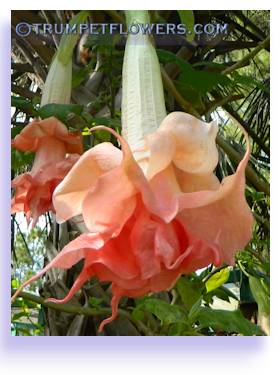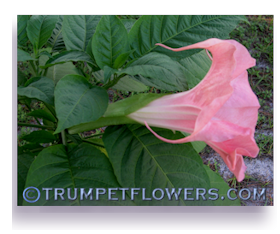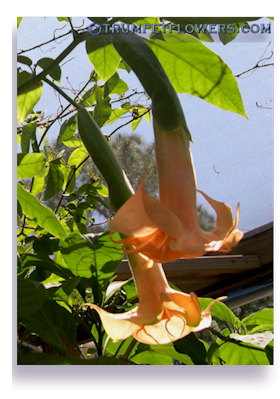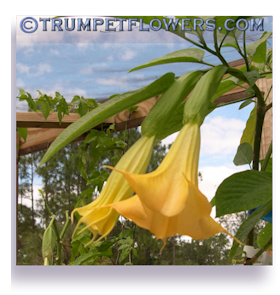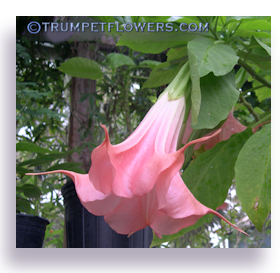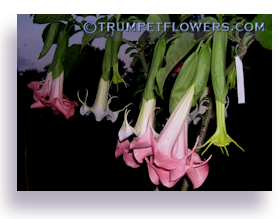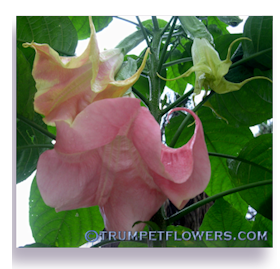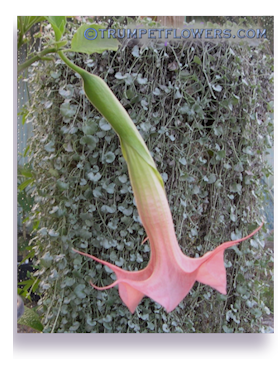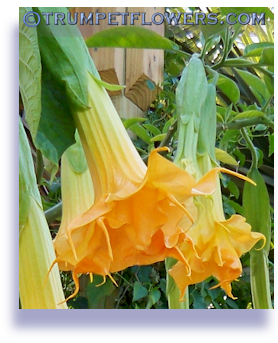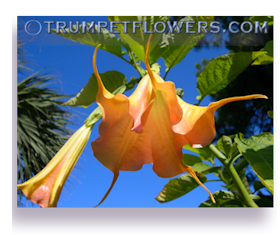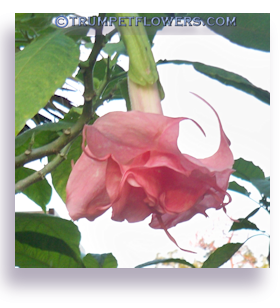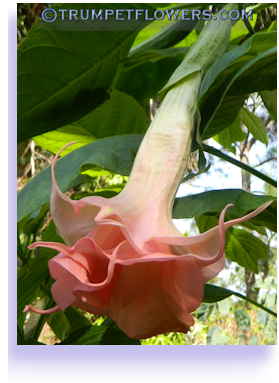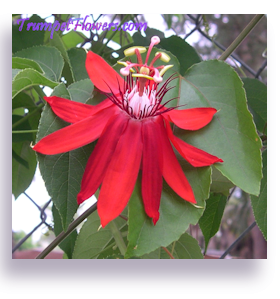Brugmansia Leaf
Problems
& Solutions
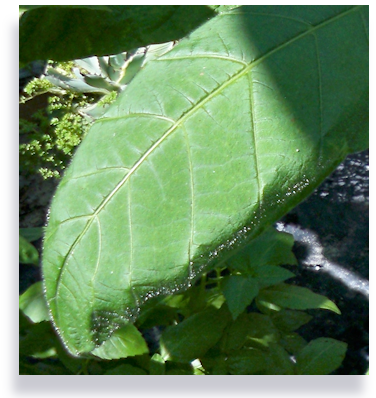 Leaves of brugmansia can tell you a lot about the overall health of the plant. Large, deep green glossy or furry leaves are the pride of any brugmansia owner. But if they begin to show signs of stress, there are several things one can do to remedy these situations.
Leaves of brugmansia can tell you a lot about the overall health of the plant. Large, deep green glossy or furry leaves are the pride of any brugmansia owner. But if they begin to show signs of stress, there are several things one can do to remedy these situations.
The angel trumpet leaf in above photo is curling under. This can be caused by a variety of things. Virus, fungus, mineral or nutrient deficiency, or insect nibbling can all be to blame. Since you can see in the picture no insect has munched on this leaf, we might be left with viral, fungal or deficency. But broadmites can do this too, and are hard to see. They suck on the undersides of the leaves, causing them to surl as the juices are removed from the leaf. Broadmites are a notorious arachnid that loves to eat at our lovely brugmansia.
If your leaves look like above photo, try Forbid for the mites, and foliar feeding.
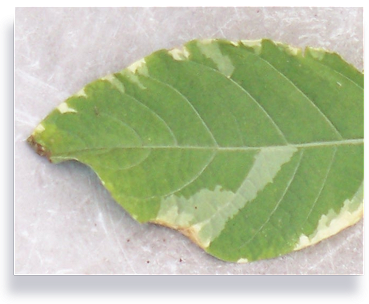
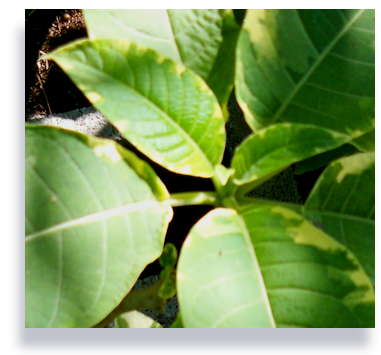 Virus and Fungus can be controlled with Bayer Advanced Fungal Control for Lawns. This leaf on Maya has a browning edge that was wettish. I began a strict routine of foliar feeding this plant once a week for a month, using Maxicrop Kelp powder mixed in a sprayer and applied in early morning hours onto dry leaves. I also added a teaspoon of the powder to a 5 gallon bucket of water and watered it in once a week for the same month. Look at the new center growth on the same plant. It is beginning to correct itself, and nutrients is what the plant needed.
Virus and Fungus can be controlled with Bayer Advanced Fungal Control for Lawns. This leaf on Maya has a browning edge that was wettish. I began a strict routine of foliar feeding this plant once a week for a month, using Maxicrop Kelp powder mixed in a sprayer and applied in early morning hours onto dry leaves. I also added a teaspoon of the powder to a 5 gallon bucket of water and watered it in once a week for the same month. Look at the new center growth on the same plant. It is beginning to correct itself, and nutrients is what the plant needed.
I also did an immediate soil drench with Banrot, which will kill many soilborne fungus. The Angel Trumpet will also systemically take some of the Banrot up the trunk and to the leaves. It worked. Within a month the new growth was free of the watery, browned leaf edges.
Oedema is a physiological condition that causes plant cells in the leaf to burst. It is brought about by temperatures in soil and air. If the ambient air temperaures are low, and the soil mix your brugmansia is sitting in is higher, and the planter has a lot of moisture or water in it, this condition can arise.
The brugmansia's root system will take the water up the trunk and through to the leaves faster than the leaves can accept the water. Combine this with the cooler air temperature, which slows down the transpiration (exchange of the gases, in this case the water vapor) and the plant cells cannot take the force, or pressure of ths volume of water and begin to burst.
This can at first create a blistering look, or watery blisters. After a day or so, the dead cells will leave a rusty red, brown or yellow color behind. This fools many into thinking their is an insect pest to blame.
Although this condition looks unsightly, it will not do overt harm to the plant. When the soil temperature and air temperature are better matched, water uptake through the trunk returns to normal.
Try to avoid this from occuring by watering the brugmansia less when these temperature conditions are present. You can also use fans where appropriate. This moves the air mass and helps with transpiration. Remove the affected leaves, the Angel trumpet will quickly grow them back.
![]() Click Here for a photograph of a flower of Brugmansia suffering from Oedema.
Click Here for a photograph of a flower of Brugmansia suffering from Oedema.
There is more on oedema at UM Extension University. Some good pictures of it too.
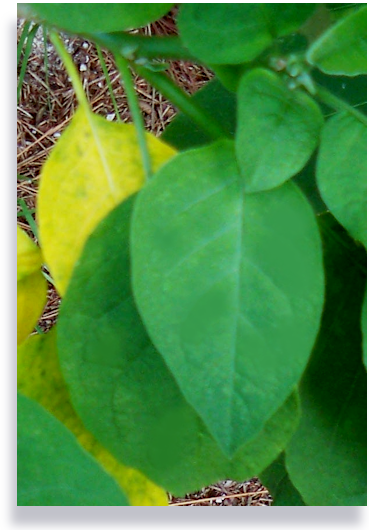 Yellowing leaves on Brugmansia naturally occur in all Angel Trumpet cultivars. Just like pine trees, brugmansia will naturally shed or drop a few leaves as new ones begin to grow out and replace them, so do not be alarmed when a few turn yellow and fall off through the seasons. However, if you notice a drastic change, and many leaves begin to yellow and drop suddenly, you could be using too much nitrogen in your fertilizing routine. Cut down on the the nitrogen number in the fertilizer, and see if that helps. It could also mean the opposite...not enough nitrogen. If you are amiss with fertilizng your brugs often enough, then try stepping up your fertilizing regiment.
Yellowing leaves on Brugmansia naturally occur in all Angel Trumpet cultivars. Just like pine trees, brugmansia will naturally shed or drop a few leaves as new ones begin to grow out and replace them, so do not be alarmed when a few turn yellow and fall off through the seasons. However, if you notice a drastic change, and many leaves begin to yellow and drop suddenly, you could be using too much nitrogen in your fertilizing routine. Cut down on the the nitrogen number in the fertilizer, and see if that helps. It could also mean the opposite...not enough nitrogen. If you are amiss with fertilizng your brugs often enough, then try stepping up your fertilizing regiment.
If you have recently sprayed a copper based fungicide, it could also have caused the Angel trumpet to drop a few leaves. If you sprayed it with too strong of a mix of copper, it might even burn the trunk and stems.
The most common nutrient problem associated with chlorosis is lack of iron, but yellowing may also be caused by zinc, lack of manganese, or, as previously mentioned; nitrogen deficiencies.
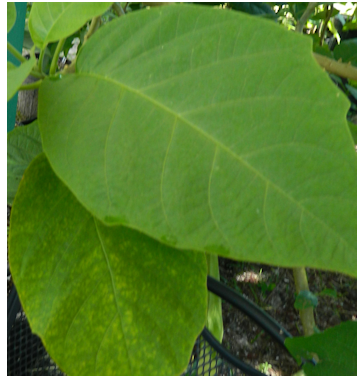 Brugmansia are not deciduous, and should retain most of their leaves year round. Like an evergreen, they shed the older leaves so that new ones can grow in and replace them. If they do drop all at once, the plant has either had too much cold exposure (a light frost maybe?), a pest infestation can cause this, or chemical burning, such as using too much of a copper fungicide spray or some other pesticide or fungicide application applied to it.
Brugmansia are not deciduous, and should retain most of their leaves year round. Like an evergreen, they shed the older leaves so that new ones can grow in and replace them. If they do drop all at once, the plant has either had too much cold exposure (a light frost maybe?), a pest infestation can cause this, or chemical burning, such as using too much of a copper fungicide spray or some other pesticide or fungicide application applied to it.
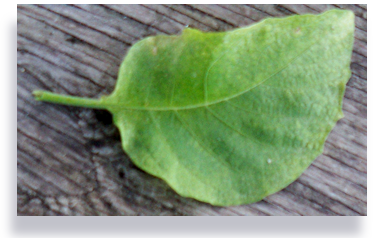 Spidermites and broadmites are notorious pests to brugmansia, and attack the leaves with voracity. If you notice hardened, twisted or curling leaves, or leaves with a fine webbing, and overall dusty look to them (see photo) then you most likely will be up against these nasty arachnids.
Spidermites and broadmites are notorious pests to brugmansia, and attack the leaves with voracity. If you notice hardened, twisted or curling leaves, or leaves with a fine webbing, and overall dusty look to them (see photo) then you most likely will be up against these nasty arachnids.
Use Bayer Insect Disease and Mite Control to fight them off, and stay on the spraying schedule the bottle recommends. It will get rid of them. If you need something stronger, BGI Classifieds usually carry a supply of Forbid or Avid in quantities that are much more affordable than the 300.00 dollars or so amounts sold everywhere else. Forbid will definitelty knock them out.
 Brown spots with yellow circling on brugmansia leaves are a sign of a possible virus. See photo and writeup on Bacterial Leaf Spot Here.
Brown spots with yellow circling on brugmansia leaves are a sign of a possible virus. See photo and writeup on Bacterial Leaf Spot Here.
Dappled leaves, or two tones of green spotting on your angel trumpet leaves can be from a couple of things. The worst would be CDV or 'Columbian Datura Virus,' photo and writeup Here. It could also be from too much salt in the soil, which can build up over time from fertilizers. Fertilizers are salts, and without completely washing them out of the pots now and again, they can create a horrible looking leaf condition similar to that in the CDV picture.
A few years back, I used epsom salts in a weakened state to help boost my brugmansia. Many gardeners had recommended it, and even though I was afraid to use the strength they suggested, I did use it and it instantly did a mass 'flip out' to the two brugmansia plants that I experimented with it. I will never do that again! It took my plants almost 9 months to grow out of this condition, even though I flushed the soil after about a month after initially using them. The leaves looked almost identical to Alistair's photo of CDV.
To each his own, but I will never put epsom salts directly on my brugmansia again. Perhaps my particular soil mix, PH, etc. had something to add to why this occured, as some Brugmansia Growers do use it without this experience. I do add a touch of it to my brugmansia tea recipe, but that is so diluted it does no harm at all.
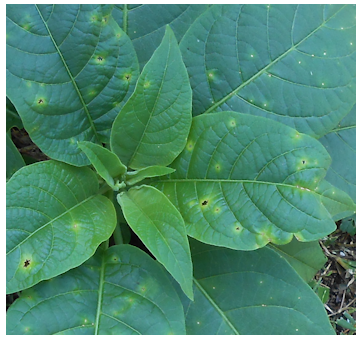 The photo to your left shows Whitefly damage. These horrible minute pests are like flying dustspecks, causing the terror you can see in the picture. Control methods include good air circulation, as they are so delicate that a good wind can keep them from staying around, and keeping the brugmansia spaced far enough apart that the air can move. Sprays like Neem will help keep their numbers down, but it must be used frequently to have any effect. But, Neem is organic, so if you have a small enough collection, it is a good choice.
Here's more on what can be done about whiteflies: Whitefly control methods.
The photo to your left shows Whitefly damage. These horrible minute pests are like flying dustspecks, causing the terror you can see in the picture. Control methods include good air circulation, as they are so delicate that a good wind can keep them from staying around, and keeping the brugmansia spaced far enough apart that the air can move. Sprays like Neem will help keep their numbers down, but it must be used frequently to have any effect. But, Neem is organic, so if you have a small enough collection, it is a good choice.
Here's more on what can be done about whiteflies: Whitefly control methods.
Thrips are a tiny, destructive insect pest that leave brown spots all over your prized brugmansia leaves. To learn more about them, asnd view the damage they cause, use this link: Thrip Damage to Brugmansia Leaves.
Boron and Calcium deficency in brugmansia can cause stunted, curled up and brown edged leaves. It looks similar to what chewing insects may do, (see below) but with some slight differences. If you are having problems like this, try adding a calcium and boron addition to your feeding routine.
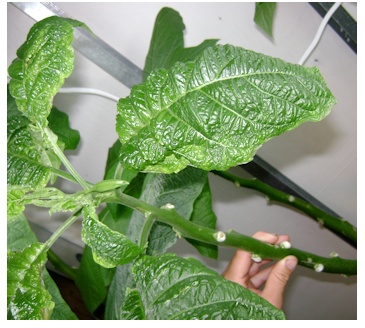 Here are some brugmansia leaves that a few of my esteemed Brugmansia Growing friends and I looked over to try and diagnose. Main consensus, Insect damage. Aphids, Whiteflies and other chewing insects suck the life juices out of the leaves and leave them unable to support the cells inside. They curl and twist, deform. Carefully remove damaged leaves and throw in burnpile or bag up for garbage. Make sure not to clip off any growing tips of brugmansia. In the future, treat your plants before the flying insect pests are ready to emerge, and you should be able to avoid this. Where I live, treatment goes on through out the year. South Florida is infamous for her bugs.
Here are some brugmansia leaves that a few of my esteemed Brugmansia Growing friends and I looked over to try and diagnose. Main consensus, Insect damage. Aphids, Whiteflies and other chewing insects suck the life juices out of the leaves and leave them unable to support the cells inside. They curl and twist, deform. Carefully remove damaged leaves and throw in burnpile or bag up for garbage. Make sure not to clip off any growing tips of brugmansia. In the future, treat your plants before the flying insect pests are ready to emerge, and you should be able to avoid this. Where I live, treatment goes on through out the year. South Florida is infamous for her bugs.
The Brugmansia experts also suggested throwing everything at the Angels. Meaning, make sure you are fertilizing, foliar feeding, using a balanced plant food with the 17 micronutrients plants need, and making sure the plant has been watered enough. Keeping the plant strong, helps it repel pests and disease.
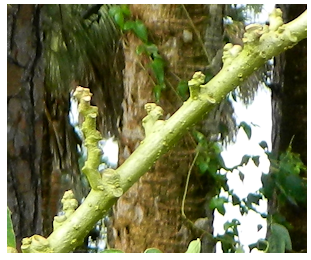 The photo shown here is the results of accidentally pinching off the growing tip of a brugmansia. Just like tropical fruit trees, pinching off the growing tip of an Angel trumpet will result in immediate, and drastic, branch growth along each node of the branch this was done to. Unless you want the branches to further propagate the plant, this is not considered a very lovely appearance and is therefore undesirable to most brugmansia growers. So be careful when pinching off any affected leaves by the tip.
The photo shown here is the results of accidentally pinching off the growing tip of a brugmansia. Just like tropical fruit trees, pinching off the growing tip of an Angel trumpet will result in immediate, and drastic, branch growth along each node of the branch this was done to. Unless you want the branches to further propagate the plant, this is not considered a very lovely appearance and is therefore undesirable to most brugmansia growers. So be careful when pinching off any affected leaves by the tip.
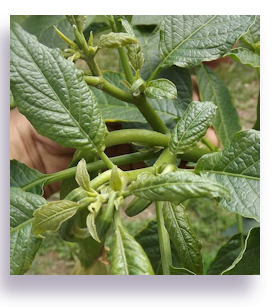 This is broad mite damage. A pretty bad case, to be sure, but it will help you recognize just what it looks like. Broad mites harden off the leaves, and leave a shiny, almost metallic look to the leaf. All of these leaves will have to be pinched, being careful with the very tip, and then treated with a broad mite systemic such as Forbid.
This is broad mite damage. A pretty bad case, to be sure, but it will help you recognize just what it looks like. Broad mites harden off the leaves, and leave a shiny, almost metallic look to the leaf. All of these leaves will have to be pinched, being careful with the very tip, and then treated with a broad mite systemic such as Forbid.
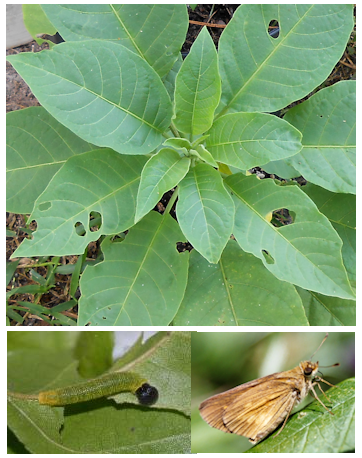 Skippers of all sorts, especially the brown and gray winged species, will randomly attack your brugmansia. Like the weevil larvae, they will also eat into the growing tips, and even flower buds, of your brugmansia. The holes they leave in the leaves are usually small, and oddly shaped, giving some identification as to what it is, a skipper caterpillar.
Skippers of all sorts, especially the brown and gray winged species, will randomly attack your brugmansia. Like the weevil larvae, they will also eat into the growing tips, and even flower buds, of your brugmansia. The holes they leave in the leaves are usually small, and oddly shaped, giving some identification as to what it is, a skipper caterpillar.
For more photos and information on skipper larvae, you can visit ButterflyNature.com
Hawkmoths leave much larger carnage behind, being a voracious caterpillar that is 50 times the adult size of the skipper caterpillars. Skipper caterpillars can be hand picked off the plant by turning over the leaf and looking along the vein. Look closely, some are green and hard to see. Caterpillar droppings on a lower leaf will tell you he may be on the leaf above.
Tags: brugmansia leaf problems,, brugmansia leaf problems, curling leaves, yellow leaves, fungus on leaf, brown spotting on leaf, hard leaves, twisted brugmansia leaf, fungal problems in plants, plant diseases,
